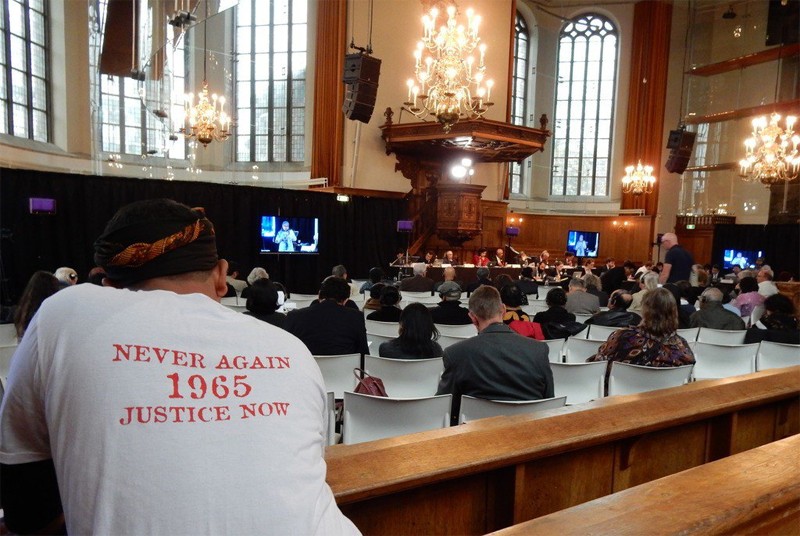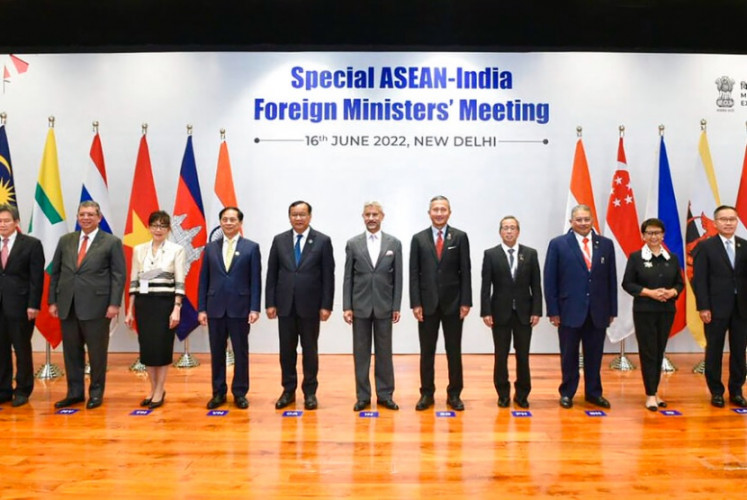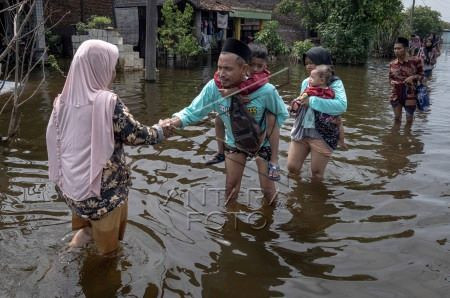Wiping out 1965 stigma
Stigmatization began in early October of 1965, following an aborted coup attempt blamed on the Indonesian Communist Party (PKI), and continued through the days of the New Order to the era of reform. It first came to life when news about the torture of Army generals at Lubang Buaya was broadcast.
Change Size
 The International People's Tribunal (IPT) on 1965 crimes against humanity in Indonesia is held in the Nieuwe Kerk in The Hague, the Netherlands, on Nov. 10 to 13. (Courtesy of the International People’s Tribunal 1965/-)
The International People's Tribunal (IPT) on 1965 crimes against humanity in Indonesia is held in the Nieuwe Kerk in The Hague, the Netherlands, on Nov. 10 to 13. (Courtesy of the International People’s Tribunal 1965/-)
E
rving Goffman (1968) suggested that stigma was any form of physical and social attributes or signs that diminish the social identity of an individual, disqualifying the person from full social acceptance.
Still quoting Goffman, there are three types of stigma: first, one relating to physical disability; second, personal weakness or defamation of an individual’s character or background; third, social stigma that is associated with group, race or religion. The stigma of 1965 falls under the second and third categories.
Stigmatization began in early October of 1965, following an aborted coup attempt blamed on the Indonesian Communist Party (PKI), and continued through the days of the New Order to the era of reform. It first came to life when news about the torture of Army generals at Lubang Buaya was broadcast.
News reports claimed that members of the Indonesian Women’s Movement (Gerwani), the female wing of the PKI, had cut off the genitals and gouged out of the eyes of the high-ranking officers.
The smear campaign aimed to expose the public to images that showed how cold-blooded people who embraced communism were. A visum et repertum released later proved the contrary but the government did not clear its publication.
People’s anger toward the PKI and its mass organizations, with pre-existing horizontal conflicts supporting this sentiment and triggered by ensuing military operations, led to mass arrests and killings, mostly in Central Java, East Java and Bali.
A couple of weeks after the coup, Gen. AH Nasution commissioned the Lembaga Sejarah (History Agency) and the Defense and Security Staff, with the assistance of historians from the University of Indonesia, published a book, 40 Hari Kegagalan “G.30.S”, 1 Oktober-10 November 1965 (The 40 Days of the Aborted Sept. 30 Coup, Oct. 1 to Nov. 10, 1965).
In October 1965, Maj. Gen. Soeharto was assigned to run operations to restore security and public order. Classification of those involved in the G30S was later decreed: Class A (involved and tried), Class B (lacking evidence for trial), Class C (supporter).
The grouping was, in practice, not set according to the appropriate criteria. People wishing to work as civil servants were required to produce a “G30S-free certificate” from the police.
In 1981 the minister of home affairs issued an instruction that did not allow those involved in G30S and their family members to join the Civil Service and the Armed Forces, or fill in other strategic jobs such as teacher and priest.
On April 17, 1990, president Soeharto, through Presidential Decree No. 16/1990 ordered a special assessment of civil servants. Candidates for civil service jobs (pending appointment) or active civil servants to be assigned specific duties were regularly scrutinized regarding their own or any of their family members’ involvement in G30S.
The engineering of history took form in history studies, building monuments and museums, film production and observation of historical events.
The National History of Indonesia (Sejarah Nasional Indonesia), edited by Nugroho Notosusanto (Book 6) and published in 1975, only discussed a sole version of the G30S story, i.e. the one saying that the movement was masterminded by the PKI. It was this version that was taught at schools.
Construction of the Pancasila Sakti Museum took place from 1967 to 1972.
In 1987, Gen. Benny Moerdani opened the Waspada Purba Wisesa Museum (to warn of the danger of extreme right-wing Islam), and in 1993 Soeharto commissioned the construction of the Pengkhianatan PKI Museum (to warn of the danger of leftist extremists).
History of National Struggle Studies (PSPB) had been a subject since 1984. Its eight objectives include ensuring that: 1) students are aware that one-sided acts by the PKI represent unilateral coercion to destroy the Unitary State of the Republic of Indonesia; 2) students realize that action fronts against the PKI were driven by the courage to defend freedom and justice; 3) students believe that the New Order put first the interests of the State and its People.
Post-reform marked the revision of the history syllabi, such as in the 2004 competence-based curriculum, where “G30S” was written without the added “PKI”, and various versions of the 1965 event were taught. In 2006, however, the New Order version of history once again took the stage.
Two accusations are always used to stigmatize people associated with communism.
First, they are ruthless; a claim that has been around since early October 1965 when Gerwani were falsely accused of cutting off the genitals and cutting out the eyeballs of the generals.
Second, they despise religion. Since the 1960s issues about land and estates have been hot topics in the country. On Nov. 3, 1961, farmers in Jengkol, Kediri, arranged a large-scale rally, and on Nov. 15, 1961, shootings by the security force resulted in the death of dozens of them.
In the Bandar Betsy affair of May 14, 1965, in South Sumatra, hundreds of farmers killed Second SubLt. Soejono. In Kanigoro, Kediri, on Jan. 13, 1965, a Pemuda Rakyat (People’s Youth) group dispersed a training event attended by members of Pelajar Islam Indonesia (Indonesian Muslim Students), and it was consistently reported that a Quran was treaded on. The truth was the holy book was safely kept inside a gunny sack.
Ayat-Ayat yang Disembelih (Slaughtered Verses, hereafter AAYD) by Anab Afifi and Thowaf Zuharon (2015) and a 2015 book by Taufiq Ismail, Matine Gusti Allah, Riwayat Palu Arit Sedunia Menajiskan Tuhan dan Agama (The Death of God, The Story of How Hammers and Sickles around the World Defile God and Religions, hereafter MGA).
AAYD lists the extreme cruelty and vulgarity that generally accompany blasphemy.
For example, “Kutil: This massacre is my protest to God”; “Kyai Soeleiman kept praising Allah when he was buried alive”; “Head pressed down with a stone, killed after leading the early morning prayers”; “After my tongue was cut by the PKI, I can no longer recite verses from the Quran”; “Quran Teacher Mutilated”; “My father was murdered by the PKI after his tarawih prayers”; “An Islamic seminarian was buried alive with his feet up”; “Gerwani poison killed Islamic boarding school students.”
AAYD contains many irrational facts. Kutil, for example, was said to have been detained in Digul following the 1926 PKI rebellious act, but managed to escape and stole a boat, which he used to sail from Papua to Tegal in Central Java.
It is suggested in MGA that mass killings of 100 to 120 million of people were recorded in communist countries worldwide. It claims that if communists had taken power in Indonesia, they would have done the same.
History discusses things that have happened, not future events. Taufiq Ismail wrote about violent acts committed by the communists while in Indonesia the fact was just the opposite.
A book edited by Stephane Curtois, Le Livre noir du communisme (1997), which the writer primarily referred to, was indeed controversial. It received harsh criticism because it was not a book on the history of communism nor the history of violence in communist countries; rather, it was a claim that crimes had been committed in communist countries costing millions of lives.
No clear data comparing those states was available. It did not distinguish mass death caused by famine from genocide.
It apparently wanted to show that the number of victims of communist regimes was many times larger than that of the German Nazi party.
Two writers of the book’s chapters, Jean-Louis Margolin (on China) and Nicolas Werth (Soviet Union) rejected the conclusion presented by Curtois.
***
The writer is a historian with the Indonesian Institute of Sciences. This article was presented in the international conference, Reconciling Indonesian History With 1965, at Goethe University, Frankfurt, on Nov. 10-12.
---------------
We are looking for information, opinions, and in-depth analysis from experts or scholars in a variety of fields. We choose articles based on facts or opinions about general news, as well as quality analysis and commentary about Indonesia or international events. Send your piece to community@jakpost.com. For more information click here.








